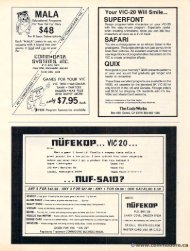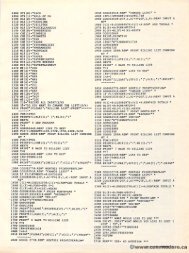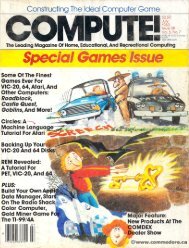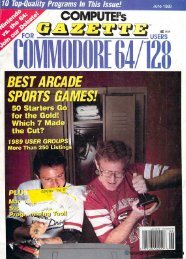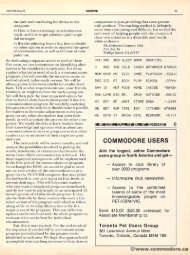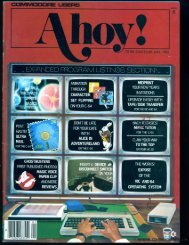May June 1980 - Commodore Computers
May June 1980 - Commodore Computers
May June 1980 - Commodore Computers
You also want an ePaper? Increase the reach of your titles
YUMPU automatically turns print PDFs into web optimized ePapers that Google loves.
MAY/JUNE. WAY/JUNE. <strong>1980</strong>. I960. ISSUE 4. 4 COMPUTE. 37<br />
Review:<br />
PET AND THE IEEE 488 Bus (GPIB),<br />
by Eugene Fisher and C. W. Jensen.<br />
Osborne/McGraw Hill, 233 pp. $15.00<br />
$15.OO<br />
Review by<br />
Review by<br />
Jim Butterfield<br />
The IEEE-488 bus may be a small part of the overall<br />
PET/CBM system, but there's enough in it to fill a<br />
book - and then some. One gels gets the impression<br />
ion<br />
that Fisher and Jensen could have gone on for<br />
another 200 pages or so without exhausting the subject.<br />
It's a very thorough book, and it documents<br />
the IEEE-f88 IEEE-488 bus and PET's role in considerable<br />
detail: line by line, command by command. The book<br />
is primarily y aimed at hardware enthusiasts and engineering<br />
types; but even the casual user r who just plugs<br />
in and hopes it works will find useful information<br />
here. There are general descriptions of what goes on,<br />
with liberal sketches depicting the interactionn in a<br />
somewhat whimsical form. There are extensive lists of<br />
compatible equipment and descriptions of applications.<br />
There'ss even a short diagnostic test which may<br />
help pinpoint t trouble on the e bus.<br />
For those who need to plunge into technical<br />
detail, it's all there: from connector pin designations<br />
to lO signal sequences, everything is spelled ed out in<br />
detail. Chapter 5, "Execution and Timing Sequences",<br />
is the longest chapter in the book. It contains<br />
step-by-step outlines of everything that happens<br />
on the bus for every relevant evant PET Basic command.<br />
There arc are a few things the authors didn't tackle.<br />
Chapter 6 deals with interfacingg non-standard devices.<br />
The interface described is for a receive-only device<br />
which responds to everything the PET sends. A<br />
schematicc is given, , and a subsequent chapter details<br />
a similar interface to the Centronics PI printer.<br />
But the design of a selecting interface, which can be<br />
called in as needed by the PET, is not touched<br />
upon. Even a brief outline here would have been<br />
useful.<br />
Similarly, il the authors stay away from the question<br />
of multiple PETs communicatingg with each other or<br />
with a common device over the CPIB GPIB bus. It's ' s a<br />
tricky subject and laced with pitfalls; users lI would<br />
have been grateful for r any hints they might have<br />
been given.<br />
Even so, the e book has a wealth of detail on<br />
all levels. There's hardly a page without a diagram,<br />
chart, , illustrationn or photograph. . Timing questions<br />
and logic sequences are described meticulously.<br />
The book is remarkably fl·ee free from errors. A few<br />
creep in: table 5-122 seems to have omitted the<br />
""unlisten" " signal; page 72 should show an EOI on<br />
the last E of GENE; page 109 seems to show the<br />
CRR and EOI coming from the PET rather than the<br />
external device. The sequence given on page 83:<br />
OPEN 5,5 "TEST"" doesn't seem to work on myy<br />
PET: it gives a syntax error. The authors might<br />
have mentioned the one-character delay that PET<br />
introduces in the output (so that it can append the<br />
EOI signal at the right time).<br />
I would have liked to see more attention given<br />
to multiple devices. At first glance, it appears that<br />
since PET only works one device at a time, the<br />
single-talker, single-listener listener description is adequate.<br />
But all devices arc are on-line during the selection sequences;<br />
and it seems to be important t to emphasize<br />
that any device can pull a line to true aand all<br />
devices must release ease the line to false. That's the<br />
whole point behind the three-wire handshake; yet I<br />
couldn'tt find the information in the introductory<br />
section. .<br />
But what the book is missingm is minor compared<br />
to what it's gOl. got. It's a gold mine of both con-<br />
ceptual information and hard facts. It covers hardware,<br />
software, mechanical assemblies, and standards.<br />
It lists numerous us devices and gives copious references.<br />
In short, it's virtually everything you wanted to<br />
know about the IEEE-488 l bus .. or are likely to want<br />
lO to knO\·v know in thee future.<br />
©<br />
Money Back Guaranlee<br />
~.-<br />
Dealer Inqulrt •• Welcome<br />
UNDERSTANDING YOUR PET/CBM<br />
Volume I: Basic Programming<br />
New 248-page book Includes all the former TIS workbooks<br />
except "PET Graphics." Provides Information for both ROMs and<br />
a comprehensive Index. Only $14.95.<br />
Also Irom from TIS<br />
W8-3 WB-3 PET Graphics $4.95<br />
Software produclS products 00 on cassette Of or Uoppy floppy disk with wilh complete instruction<br />
manual. Each S24.95 S2-S.95 (cassette). $29.95 (diskette).<br />
SW-l SW-1 MAIL B mailing list system<br />
SW-2 CHECKBOOK record<br />
SW-3 ACCOUNTS keep track 01 of who owes you how much<br />
SW-4 MEOI MEDITT create and maintain date Iiles<br />
files<br />
SW-5 CALENDAR appOintments. appointments, meetings at·a-glance<br />
at-a-glance<br />
TtS TIS<br />
P.O. Box 921, Dept. C<br />
Los Alamos, Alamos. NM 87544<br />
Add S2 $2 (S5



